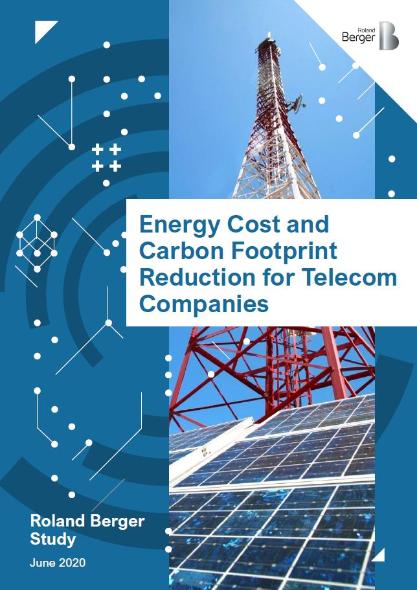Energy Cost and Carbon Footprint Reduction for Telecom Companies
![{[downloads[language].preview]}](https://www.rolandberger.com/publications/publication_image/Cover_energy-cost-and-carbon-footprint_study_download_preview.jpg)
A comprehensive carbon footprint strategy can reduce CO2 emissions by 20-25% and reduce energy cost by 20-30%.


The telecom sector has set ambitious targets to tackle climate change and decarbonize. GSMA, in partnership with the International Telecommunication Union (ITU) and the Global e-Sustainability Initiative (GeSI), has developed a pathway to reduce greenhouse gas emissions across the sector.
The pathway targets a 45% emission reduction by 2030 and net zero emissions by 2050 for the sector. Leading telecommunication companies have already announced their own ambitious decarbonization goals. For example, Singtel and Telenor have announced net zero emissions by 2050, in line with the overall sector targets, and Orange by 2040.
Realizing telecom companies' decarbonization targets will require a major shift in how operators, tower companies and data centers manage their energy needs. Indeed, in a "business-as-usual" scenario without carbon footprint or cost reduction measures, telecom companies' energy consumption and footprint would actually increase rapidly, due to 5G. Even though 5G is more energy efficient on a per-bit basis, overall energy consumption can be significantly higher because of two main factors: (i) more sites and antennas, and (ii) accelerated increase in data.
"Without mitigation measures, energy costs would increase to around 32% of network costs. Therefore, with operators moving to 5G, reducing energy costs will become imperative for telecom companies."
To reduce energy costs and carbon emissions, telecom companies can tap into three opportunities: (1) Improving energy efficiency of its operations to lower energy demand; (2) Adopting renewable energy sources and decentralized solutions, whereby renewable electricity is generated locally; and (3) Outsourcing energy to specialized providers.
There is a wide range of options available for telecom companies to reduce their energy costs and carbon footprint. They can improve energy efficiency (e.g. through intelligent sleep mode, climate control, modification or modernization of infrastructure, remote and intelligent monitoring and management of power solutions) and adopt renewable and decentralized solutions (e.g., on-site decentralized renewables, corporate PPAs or carbon offsetting). These options can be done internally or by outsourcing to specialized providers, such as ESCOs.
Whether to outsource energy supply or not, and which levers to employ, also depends on the type of asset or individual site. Assets first need to be categorized in terms of criticality (for example, profit impact in case of power failure), including by tower location and by type of equipment (RAN, MIMO, battery trays, etc). Service level agreements, such as uptime, need to be defined for each asset type, depending on the criticality. Each level of criticality is tied to a corresponding SLAs that need to be defined first, before engaging with external parties (e.g. ESCOs).

![{[downloads[language].preview]}](https://www.rolandberger.com/publications/publication_image/Cover_energy-cost-and-carbon-footprint_study_download_preview.jpg)
A comprehensive carbon footprint strategy can reduce CO2 emissions by 20-25% and reduce energy cost by 20-30%.

